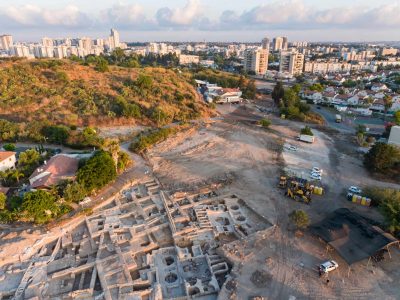
 Yavne was a world wine powerhouse about 1,500 years ago. A huge and well-designed industrial estate from the Byzantine period with a very impressive wine production complex—the largest known in the world from this period—has been excavated in the city over the past two years. The site includes five magnificent wine presses, warehouses for aging and marketing the wine, kilns for firing the clay amphorae in which the wine was stored, tens of thousands of fragments and intact earthen amphorae (jars), well planned access between the facilities and more.
Yavne was a world wine powerhouse about 1,500 years ago. A huge and well-designed industrial estate from the Byzantine period with a very impressive wine production complex—the largest known in the world from this period—has been excavated in the city over the past two years. The site includes five magnificent wine presses, warehouses for aging and marketing the wine, kilns for firing the clay amphorae in which the wine was stored, tens of thousands of fragments and intact earthen amphorae (jars), well planned access between the facilities and more.
Each of the exposed winepresses covered an area of about 225 square meters [2,422 sq. ft.]. Around the treading floor, where the grapes were crushed barefoot to extract the liquid, compartments were built for fermenting the wine, and next to them, two huge octagonal-shaped vats for collecting the wine.
Dr. Elie Haddad, Liat Nadav-Ziv and Dr. Jon Seligman, the directors of the excavation on behalf of the Israel Antiquities Authority [IAA], noted: “We were surprised to discover a sophisticated factory here, which was used to produce wine in commercial quantities. Furthermore, decorative niches in the shape of a conch, which adorned the winepresses, indicate the great wealth of the factory owners. A calculation of the production capacity of these winepresses shows that approximately two million liters [528,344 gal.] of wine were marketed every year, while we should remember that the whole process was conducted manually.”
Between the winepresses, four large warehouses were discovered, which formed the winery of the factory. The wine is aged in elongated amphorae, known as “Gaza jars.” The jars themselves, some of which were discovered complete, together with hundreds of thousands of their fragments, were made at the site in large kilns.
“Gaza and Ashkelon wine was considered a quality wine brand of the ancient world, with a reputation that had spread far and wide, a bit like Jaffa oranges denote their origin and quality today from Israel,” the archaeologists explained.
“Everyone knew that this was a product from the Holy Land, and everyone wanted more and more of this wine. The wine received its name as it was marketed through the ports of Gaza and Ashkelon. So far, other sites where wine was produced are known from the southern coastal plain, but now, we seem to have found the main production center of this prestigious wine. From here, commercial quantities were transported to the ports, and then throughout the Mediterranean basin.”
Excerpt from a press release by the IAA
Photo Credit: Assaf Peretz/IAA
All logos and trademarks in this site are property of their respective owner. All other materials are property of Bridges for Peace. Copyright © 2025.
Website Site Design by J-Town Internet Services Ltd. - Based in Jerusalem and Serving the World.